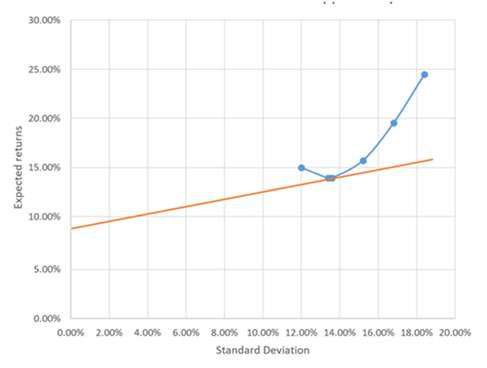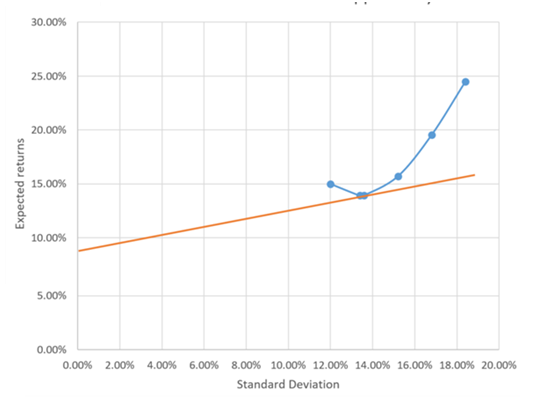
To calculate: The investment opportunity set of the two risky funds is to be tabulated along with the graph.
Introduction: The portfolio risk is defined as the combination of assets which carries its own risk with each investment.
The standard deviation is used to determine that in which manner the values from a data set vary from its mean value. This is calculated by the square root of the variance.
The expected return is defined as the return which is obtained on the risky asset that is expected in future.
Answer to Problem 5PS
Expected return for the portfolio = 13.39%
Standard deviation for the portfolio =
The graph is represented as −

Explanation of Solution
The following formula will be used to calculate the expected return of the portfolio for different proportions of stock and bond-
Where,
The following formula will be used to calculate the standard deviation of the portfolio for different proportions of stock and bond-
The three mutual funds are −
- Stock fund
- Long term government and corporate bond fund
- T-bill money market fund with yield 8%
The probability distribution of the risk fund is given as −
| Expected return | Standard deviation | |
| Stock fund (S) | 20% | 30% |
| Bond fund (B) | 12 | 15 |
The correlation between fund return = 0.10
The minimum variance portfolio is calculated as-
The weight of the stock fund in minimum variance portfolio is calculated as-
For bonds funds:
Put the calculated values in Equ (1) for expected return −
Put the calculated values in Equ (2) for the standard deviation-
The graph between expected return and standard deviation is called as investment opportunity set which is represented as −

Want to see more full solutions like this?
Chapter 7 Solutions
GEN COMBO LOOSELEAF INVESTMENTS; CONNECT ACCESS CARD
- What is the time value of money, and why is it important in financial decision-making?arrow_forwardPlease don't use chatgpt. The formula for calculating the present value of a future amount is:A) Future Value × (1 + r)^nB) Future Value ÷ (1 + r)^nC) Future Value × (1 - r)^nD) Future Value ÷ (1 - r)^n help in this question.arrow_forwardThe formula for calculating the present value of a future amount is:A) Future Value × (1 + r)^nB) Future Value ÷ (1 + r)^nC) Future Value × (1 - r)^nD) Future Value ÷ (1 - r)^n need help!arrow_forward
- no ai What is the primary purpose of diversification in investing?A) To maximize returnsB) To eliminate all riskC) To reduce unsystematic riskD) To ensure stable dividendsarrow_forwardno chatgpt Which of the following is a capital structure decision?A) Deciding how much to pay in dividendsB) Deciding how to allocate funds to various projectsC) Deciding the mix of debt and equity financingD) Deciding how much inventory to purchase need help!arrow_forwardWhich of the following is a capital structure decision?A) Deciding how much to pay in dividendsB) Deciding how to allocate funds to various projectsC) Deciding the mix of debt and equity financingD) Deciding how much inventory to purchasearrow_forward
- No chatgpt!! The weighted average cost of capital (WACC) is used to:A) Measure the profitability of a companyB) Determine the cost of debt financing onlyC) Calculate the company’s average cost of financing from debt and equityD) Estimate the future stock price need help.arrow_forwardNo AI The weighted average cost of capital (WACC) is used to:A) Measure the profitability of a companyB) Determine the cost of debt financing onlyC) Calculate the company’s average cost of financing from debt and equityD) Estimate the future stock pricearrow_forwardCost of Trade Credit A large retailer obtains merchandise under the credit terms of 3/20, net 35, but routinely takes 65 days to pay its bills. (Because the retailer is an important customer, suppliers allow the firm to stretch its credit terms.) What is the retailer's effective cost of trade credit? Assume a 365-day year. Do not round intermediate calculations. Round your answer to two decimal places. The answer is not 27.09 which is incorrect.arrow_forward
- You invest $1,000 a year for 10 years at 6 percent and then invest $2,000 a year for an additional 10 years at 6 percent. How much will you have accumulated at the end of the 20 years? Answer: $49,967 *Please include all work & formulasarrow_forwardNo ai please! What is the role of an underwriter in an IPO?A) To lend money to the companyB) To set the dividend policyC) To buy the securities and sell them to the publicD) To manage the company’s operations need hearrow_forwardNo ai tool What is the role of an underwriter in an IPO?A) To lend money to the companyB) To set the dividend policyC) To buy the securities and sell them to the publicD) To manage the company’s operationsarrow_forward
 Essentials Of InvestmentsFinanceISBN:9781260013924Author:Bodie, Zvi, Kane, Alex, MARCUS, Alan J.Publisher:Mcgraw-hill Education,
Essentials Of InvestmentsFinanceISBN:9781260013924Author:Bodie, Zvi, Kane, Alex, MARCUS, Alan J.Publisher:Mcgraw-hill Education,

 Foundations Of FinanceFinanceISBN:9780134897264Author:KEOWN, Arthur J., Martin, John D., PETTY, J. WilliamPublisher:Pearson,
Foundations Of FinanceFinanceISBN:9780134897264Author:KEOWN, Arthur J., Martin, John D., PETTY, J. WilliamPublisher:Pearson, Fundamentals of Financial Management (MindTap Cou...FinanceISBN:9781337395250Author:Eugene F. Brigham, Joel F. HoustonPublisher:Cengage Learning
Fundamentals of Financial Management (MindTap Cou...FinanceISBN:9781337395250Author:Eugene F. Brigham, Joel F. HoustonPublisher:Cengage Learning Corporate Finance (The Mcgraw-hill/Irwin Series i...FinanceISBN:9780077861759Author:Stephen A. Ross Franco Modigliani Professor of Financial Economics Professor, Randolph W Westerfield Robert R. Dockson Deans Chair in Bus. Admin., Jeffrey Jaffe, Bradford D Jordan ProfessorPublisher:McGraw-Hill Education
Corporate Finance (The Mcgraw-hill/Irwin Series i...FinanceISBN:9780077861759Author:Stephen A. Ross Franco Modigliani Professor of Financial Economics Professor, Randolph W Westerfield Robert R. Dockson Deans Chair in Bus. Admin., Jeffrey Jaffe, Bradford D Jordan ProfessorPublisher:McGraw-Hill Education





